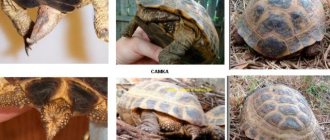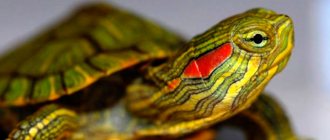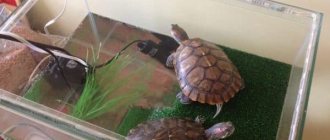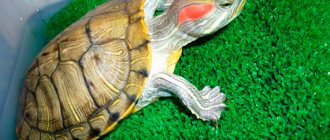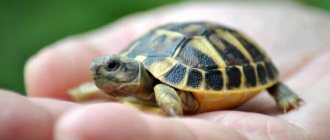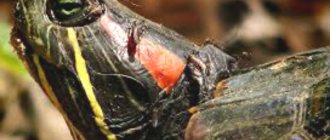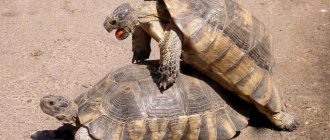There has always been and remains a fashion for exotic animals. The most common species among exotic animals is the red-eared turtle. Before you get such an exotic pet, you need to evaluate your capabilities. To keep an aquatic turtle, you will need more than just a huge aquarium. The red-eared turtle is a predator that requires special nutrition, which is quite expensive. Need to know, what to feed a red-eared turtle at hometo raise a healthy pet.
Animal feed
It is best to build a diet based on animal food. The reptile's menu consists of 60% or more animal protein .
A turtle will happily eat any meat, but it is preferable to feed it lean varieties: beef, rabbit or poultry .
Attention! It’s a good idea to diversify your pet’s diet with fish, beetles and plants.
Meat
The aquarium red ear eats meat with pleasure, but how to feed it correctly and how many times a day so as not to harm it?
The basis of the diet is necessarily lean meat . Fatty lamb and pork will lead to digestive problems, illness and even death of the pet. In addition to the protein itself, the diet should contain by-products:
- heart;
- liver;
- stomachs.
You can occasionally feed your turtle small mice.
Important! A diet of only unprocessed meat is a direct path to vitamin A deficiency and rickets. You need to diversify the list of products, then your pet will be healthy.
What kind of fish is suitable for food?
What fish should you feed your red ear? As with meat, you need to choose lean varieties. First remove bones that can harm the turtle, as well as entrails and scales.
In addition, before serving, it is recommended to dip the fish in boiling water for a couple of minutes so that the thiaminase enzyme coagulates.
A cocktail made from sea creatures would be a good addition to your diet , but you shouldn’t give it often.
Attention! The redfish will not get along in an aquarium with fish and snails - this is its natural food supply.
Insects
What do red-eared turtles eat besides food? You will be surprised - insects! In summer they add to the menu:
- grasshoppers;
- caterpillars;
- bloodworm;
- mealworm;
- gammarus;
- daphnia (but in this case it is better to turn off the filter for a while).
Other animal food options
You should not feed your turtle caught cockroaches or spiders.
Insects can be “stuffed” with toxic substances, which will certainly harm your pet.
Brief introduction
We are all in a hurry, but the article is long and I don’t want to read it. Here's a little introductory note to give you an idea of what the article is all about...
The red-eared slider is very hardy and is a good choice for beginners. On the one hand, they live a long time and often become the first species of turtles for many hobbyists, but on the other hand, people who buy them often destroy them.
They don’t know that turtles need water and land (shore), which should be warm and where UV rays should reach. At the same time, they spend most of their time in water, which must be clean, warm and regularly changed.
As a rule, all problems and diseases are caused by careless owners who do not know that dirty water causes infections; without calcium, the shell will become crooked; without heat and a UV lamp, the turtle does not absorb calcium and gets sick!
They are fast, strong and can be aggressive!
They easily attack other turtles, and each other. They are also known for their personality and charisma, which sets them apart from other turtle species.
They are very skilled when it comes to feeding and can take food from each other.
In the wild, being an invasive species, they displace and destroy endemics so much so that in Australia they are outlawed and exterminated.
Red-eared sliders can make excellent pets, if only because allergies to reptiles are rare.
However, if you decide to have her as a gift for a child, remember that all responsibility for her health and behavior lies with you!
Children cannot care for a turtle at the proper level; moreover, they can quickly lose interest in a new toy and abandon it. And she needs to be fed, water changed, warmed, even washed.
Do you know how long the red-eared turtle lives? With good care, a turtle can live from 20 to 40 years, that is, survive more than one generation of owners.
Habitat in nature
The red-eared freshwater turtle is native to North America and is especially common along the Mississippi River before it flows into the Gulf of Mexico.
She lives in a warm climate in the southern states of the USA, from Colorado to Florida. But its popularity is great and now it is often found in nature around the world, often posing a threat to local fauna.
In its natural habitat, it needs the following conditions: fresh water, places to bask, dense vegetation and for a nest. Usually these are lakes, ponds, swamps, and creeks.
It prefers bodies of water with warm water and a weak current, always with places above the surface of the water where it can climb out to warm itself. Often in such places they lie directly on top of each other. The bottom in such places is usually sandy or silty.
The habitat is usually limited to the water's edge; aquatic turtles do not like to move far from the shore, although females need solid ground to lay eggs.
Small turtles in nature feed on fish, snails, insects and various plants.
Appearance, size, life expectancy
The red-eared turtle is recognizable and difficult to confuse with other species.
A characteristic red (sometimes orange) stripe starts from the eyes and continues along the neck. The carapace (upper part of the shell), round and smooth, is olive green with black and yellow lines.
The plastron (lower part of the shell) is also smooth, yellowish in color with dark spots. Young turtles have a very bright green shell, but it darkens with age.
With age, the spots on the shell darken, and the red stripe on the head turns pale.
The size of a turtle is determined by measuring the length of the shell from edge to edge with a ruler. In this case, they do not pay attention to the curvature of the shell, so it is best to measure with a ruler rather than a tape measure.
Only hatched turtles are about 2.5 cm in length, after a year of life they grow to 5–7 cm. Males become sexually mature at a size of about 10 cm, and females 12.5.
The average size of a turtle is from 25 to 30 cm, depending on the conditions and species. Males are smaller in size than females.
Please note that size cannot be a sign of age. The fact is that at home turtles grow faster than in nature, this is the result of overfeeding and ideal conditions.
But, with proper maintenance and feeding at home, turtles live longer than their wild relatives.
A domestic turtle can live up to 40 years, while a wild turtle can live no more than 20.
Approximate sizes of the red-eared slider by year:
- 1 year: 6 cm.
- 2 years: female - 9 cm, male - 8 cm.
- 3 years: female - 14 cm, male 10 cm.
- 4 years: female - 16 cm, male - 12 cm.
- 5 years: female - 18 cm, male - 14 cm.
- 6 years: female - 20 cm, male - 17 cm.
Sense organs
The red-eared slider has well-developed senses, especially vision and smell. They can distinguish colors both in the water and above it, and can look out for nesting sites for other turtles.
They notice movement very well, at a distance of up to 40 meters, no matter if it is a prey or a predator. They also have a good sense of smell, which helps them find food.
But her hearing is not very good, her ears are covered with skin and feel only dull sounds and vibration. The shell is sensitive to touch because nerves pass through it.
In addition, they have a sense of touch and can reject unpalatable foods in favor of tastier ones.
As for sounds, it can make hissing, snorting, or short sounds like a squeak. Turtles don't breathe underwater, they rise to the surface for oxygen!
How to determine gender?
Just as pet turtles grow faster, they also become sexually mature faster. It becomes sexually mature at the age of one year, and you cannot confidently determine the sex of a turtle if its size is less than 10 cm.
More or less confidently, we can say whether it is a male or a female when the male is 2–4 years old, and the female is 3–5 years old and their size is about 10–15 cm.
True, in the case of abundant feeding, sexual maturity may become earlier.
The main differences between a male and a female are: females are larger and have a shorter tail. In addition, in the female, the cloaca is located closer to the base of the tail. An indirect sign can be the claws on the paws; in males they are longer and curved.
Of even more relative characteristics, the males have a slightly concave plastron inward, which helps him during mating.
Location of the cloaca in a female (right) and male (left)
Plant food
The diet of an adult turtle should be dominated by plant components . The older she is, the more vegetarian dishes are on the menu.
Grass
Little Reds eat their coltsfoot with gusto. Also great for:
- leaves of plantain, clover, dandelions;
- sprouted oats and barley.
Aquarium plants
Seaweed is a good addition to the menu. Duckweed, watercress and any plants from natural bodies of water are suitable
Vegetables
Turtles love kibble:
- bell peppers;
- zucchini;
- eggplant;
- cucumbers;
- tomatoes;
- carrots;
- beets;
- pumpkins.
Mushrooms
Once a week, champignons, russula or boletus , cut into small pieces, are added to the regular diet.
What should you not feed your red-eared turtle?
Despite the fact that this armored reptile is considered an omnivore, there is a certain list of foods that are strictly contraindicated for these animals. The list of foods harmful to turtles includes the following components:
- poisonous land plants and algae (Elodia, Ambulia, Legendandra);
- plant and animal products containing large amounts of oscalates, phosphorus, purines (tomatoes, cabbage, raw liver, fatty meat, etc.);
- poisonous and poisonous insects;
- locusts and grasshoppers with serrated stalks;
- fatty meat and fish;
- bread, potatoes, etc.
Many of the above foods contain substances that can lead to the development of diseases such as gout, goiter and iodine deficiency in the turtle. The seemingly beneficial phosphorus interferes with the absorption of calcium, which also applies to oscalates.
Artificial feed
Pet stores generously offer a wide variety of food for turtles , but such mixtures do not cover the reptile’s need for proteins and microelements.
Homemade food
If store-bought food is not suitable for your turtle, you can prepare the food yourself.
Take:
- 50 g cabbage;
- 70 g carrots;
- 150 g lean fish;
- 50 g apples;
- 100 g squid meat.
The products are passed through a meat grinder or crushed with a blender . Add 2 eggs, gelatin (1 tablespoon per 150 ml of water) and 150 ml of milk to the mixture. Mix everything thoroughly and store in the refrigerator for no more than a week.
This amount of food is enough for about 10 servings for one small turtle. Before serving, food is cut into portions.
Is it possible to give turtles dog/cat food?
Although turtles eat commercial cat and dog food with great pleasure, such a diet does not benefit them.
Such mixtures do not contain the microelements necessary for reptiles, and abuse of such a diet will lead to serious health problems for the turtle .
How often and at what time should you feed your turtles?
A difficult question that cannot be answered unequivocally. Much depends on the age and size of the animal, and on the food you feed.
For young animals up to 1 year old, plant foods and artificial feed are suitable. Feeding should be daily.
From 1 year and older you can feed every 1-2 days. If the turtle prefers plant foods, it is recommended to feed it daily. The amount of food also depends on the age of the turtle.
Proper feeding is the main condition for the normal development of red-eared turtles. Every owner should feel his pet, choose the right food and give him what he likes and what is healthy.
Vitamin and mineral complexes
Turtles need calcium to form their shell. fill the need for microelements with the help of bone meal - it is mixed into the food.
A pinch is enough for young redears; for older ones, a teaspoon is “stretched” for a week.
In addition, special vitamins for turtles are added in accordance with the instructions, but the shelf life of such food is limited.
Diet
How often should you feed your red-eared slider? Young and actively growing individuals are fed every day. Up to a year, protein must be present in the menu (60-70% of the total diet). Upon reaching the age of 2-3 years, growth slows down. The body's energy needs decrease. For an adult turtle, it is enough to eat a large meal once every two to three days. The amount of protein consumed is reduced to 40%. On fasting days, only small quantities of green food are offered.
Reproduction of representatives of the species
Representatives of this species mate from the age of 4 (males) and from 5 years (females). In order for animals to produce offspring in the future, you need to prepare an aquarium in advance. The water level should be at least 10 cm. This is necessary so that the female does not remain without water for a long time during the mating period. Then you need to prepare a dry place where the female will lay eggs in the future.
For proper mating, there should only be one boy and one girl in the aquarium. Otherwise, male turtles will fight, and they do it very aggressively - they bite off each other’s tails and paws. After the female lays eggs, they must be transferred to an incubator - a container with sand. The layout is similar to a chicken incubator. The ideal temperature for egg maturation is 25–27 C. On average, it takes about 5 months for a turtle to be born.
Incubator container
After hatching, the babies should not be allowed into the aquarium with adults, since the latter do not have developed maternal and paternal instincts, and they can attack turtles.
If turtles are properly cared for and feeding recommendations are followed, they will delight their owners for decades.
Features of feeding small turtles
Particular attention must be paid to feeding turtles, because a deficiency of vitamins can negatively affect their development.
Young turtles are predatory animals, so they often ignore plant foods. Animal food plays a predominant role during their feeding period. They require food 1 or even 2 times every day.
Juveniles desperately need calcium and vitamin D. They should be added to their food at every feeding.
Baby turtles desperately need calcium and vitamin D intake
One of the rules for feeding baby turtles is to serve pieces of food the size of a blueberry.
What can overfeeding cause?
An important condition for the nutrition of a red-eared pet is not only a variety of diet, but also a regime. Overfeeding leads to diseases: pyramidal shell and obesity.
Not only the diet, but also the regimen is considered an important condition for nutrition.
Overeating in juveniles is extremely harmful, because they are actively developing, as well as during the adaptation period after purchasing or after illness of a red-eared turtle.
It is not recommended to force feed turtles. But long-term fasting is also contraindicated for them.
A healthy reptile should swim freely in the water and easily crawl onto the island. Excess weight will prevent the turtle from hiding its head in its shell.
